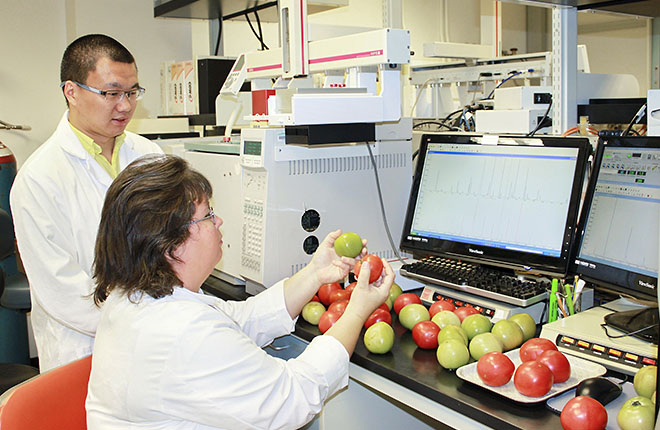Two Approaches to Tastier Tomatoes
Anyone who has ever wondered why some tomatoes can taste so bland might be interested in the work of two Agricultural Research Service (ARS) scientists in Fort Pierce, Florida. They are taking two different approaches to enhance tomato flavor.
Jinhe Bai, an ARS chemist, and his colleagues at the U.S. Horticulture Research Laboratory analyzed the effects of two common practices that he suspected affect tomato flavor. Some people refrigerate their tomatoes, and some people dip them in hot water to make them easier to peel, a practice known as “blanching.”
Bai and his colleagues divided 60 standard tomatoes into 3 groups: one group was refrigerated at 41 ˚F for 4 days; another group was kept at room temperature (68 ˚F) for 4 days and then dipped in 122 ˚F water for 5 minutes to simulate blanching; and a control group was kept at 68 ˚F for 4 days.
They then used gas chromatography and an “electronic nose” to measure the 45 volatile compounds associated with flavor released by the tomatoes when they were cut up. The electronic nose uses electronic sensors to classify food samples based on their aroma profiles. Gas chromatography was used to identify and quantify individual aromas.
The results showed that refrigeration greatly reduced 25 of the 42 aroma compounds and reduced volatile levels overall by 68 percent. Blanching the tomatoes also greatly reduced 22 of the 42 compounds and reduced volatile levels overall by 63 percent.
The results spell out why it is better for tomatoes to be stored—and washed before use—at room temperature. Shelf life generally shouldn’t be a problem, Bai says. “If tomatoes have been picked green and chilled to minimize damage, as they usually are, they will remain unspoiled for about a week at room temperature,” he says. Tomatoes from a garden or farmers market that have not been chilled also will last a few weeks at room temperatures, he adds.
Also at the Fort Pierce lab, ARS horticulturist and research leader Elizabeth Baldwin wanted to find tomato candidates for breeders interested in developing varieties with enhanced flavor. She also wanted to identify varieties and growing seasons best suited to two of Florida’s major tomato production areas.
She and her colleagues raised 38 types of tomatoes over 7 years in south Florida and in west-central Florida, timing production for March, June, and December harvesting. In any given season, they focused on five to eight genetic types.
They subjected the tomatoes to human taste-test panels and to liquid and gas chromatography to measure levels of sugars, acids, and 29 key aroma compounds. Panelists graded the tomatoes on a scale of 1 to 9 for sweetness, sourness, and overall flavor. The scientists then correlated the different varieties, harvest dates, sugars, acids, and aroma compounds with the flavors reported by the taste panels.
The results showed that the tomatoes had to contain a certain amount of acids to have adequate flavor and that the more sugar they contained, the better their flavor. They also found that flavorful tomatoes need to strike a balance by having a sufficient number of aroma compounds, while offering consumers more “fruity notes.”
In general, tomatoes harvested in June had more sugar and more fruity volatiles than those harvested in December, probably because they had more sunshine. Tomatoes harvested in March ranked in the middle in terms of flavor.—By Dennis O’Brien, ARS Office of Communications.
“Two Approaches to Tastier Tomatoes” was published in the May 2016 issue of AgResearch Magazine.
Key Facts
- Refrigerating tomatoes or dipping them in hot water causes flavor loss.
- Fresh tomatoes should be stored at room temperature.
- Taste-test results may help us breed tastier tomatoes.
Full Story







